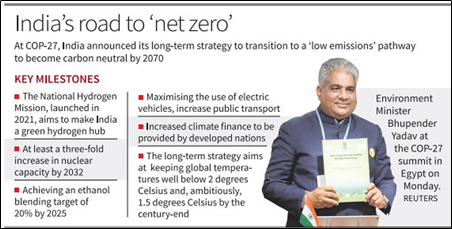ForumIAS announcing GS Foundation Program for UPSC CSE 2025-26 from 19 April. Click Here for more information.
ForumIAS Answer Writing Focus Group (AWFG) for Mains 2024 commencing from 24th June 2024. The Entrance Test for the program will be held on 28th April 2024 at 9 AM. To know more about the program visit: https://forumias.com/blog/awfg2024
Contents
Source: The post is based on the article “India Submits its Long-Term Low Emission Development Strategy to UNFCCC” published in PIB on 14th November 2022
What is the News?
India has submitted its Long-Term Low Emission Development Strategy(LT-LEDS) to the United Nations Framework Convention on Climate Change (UNFCCC) at COP 27.
What is the Long-Term Low Emission Development Strategy(LT-LEDS)?
The LT-LEDS is a commitment document which every signatory to the Paris Agreement (2015) is obliged to make by 2022.
So far, only 57 countries (including India) have submitted their document.
What is India’s Long-Term Low Emission Development Strategy(LT-LEDS)?

The strategy is based on four key considerations: 1) India has contributed little to global warming despite being home to a sixth of the world’s population, 2) India has significant energy needs for development, 3) India is committed to pursuing low-carbon strategies for development and 4) India needs to build climate resilience.
Key Pillars of the strategy: The 7 key pillars of the strategy are: 1) Low-carbon electricity systems consistent with development 2) Integrated, efficient and inclusive low-carbon transport systems, 3) Energy & material-efficiency in buildings, 4) Decoupling growth from emissions and developing an efficient, low-emission industrial system, 5) CO2 removal and related engineering solutions, 6) Enhancing forest cover consistent with socioeconomic and ecological considerations and 7) Increasing climate resilience in poverty eradication and employment creation.
What are the salient features of the strategy?
Transition from fossil fuels: The transition from fossil fuels will be undertaken in a just, smooth, sustainable and all-inclusive manner.
Transportation sector: Increased use of biofuels, especially ethanol blending in petrol, the drive to increase electric vehicle penetration and the increased use of green hydrogen fuel is expected to drive the low carbon development of the transport sector.
Sustainable Urbanization: Future sustainable and climate-resilient urban development will be driven by smart city initiatives, integrated planning of cities, effective green building codes and rapid developments in innovative solid and liquid waste management.
Industrial Sector: India’s industrial sector will continue on a strong growth path in the perspective of ‘Atma Nirbhar Bharat’ and ‘Make in India’. The focus will be on improving energy efficiency by initiatives such as Perform, Achieve and Trade (PAT) scheme, high levels of electrification, enhancing material efficiency and recycling leading to the expansion of the circular economy.
Forest Cover: India has a strong record of enhancing forest and tree cover in the last three decades alongside high economic growth.
– India’s forest fire incidence is well below global levels, while its forest and tree cover are a net sink absorbing 15% of CO2 emissions in 2016. India is on track to fulfilling its NDC commitment of 2.5 to 3 billion tonnes of additional carbon sequestration in forest and tree cover by 2030.
Transition to low-carbon development: The transition to the low carbon development pathway will entail several costs pertaining to the development of new technologies, new infrastructure, and other transaction costs. The provision of climate finance by developed countries will play a very significant role in this.




